Primary Healthcare Essay: Needs, Initiatives, and Policies - BN710709
VerifiedAdded on 2022/09/30
|13
|3512
|280
Essay
AI Summary
This essay provides an in-depth analysis of primary healthcare strategies in New Zealand, focusing on the vision of improving health outcomes and reducing inequalities. It explores the key directions of the primary healthcare strategy, including addressing health inequalities, working with local communities, and removing barriers to care. The essay examines the New Zealand cancer plan as a specific initiative, highlighting its goals of improving cancer care, ensuring equitable outcomes, and implementing prevention measures. It also delves into modifiable risk factors, particularly smoking, and discusses community initiatives aimed at reducing smoking rates and promoting healthy lifestyles, including public awareness campaigns and media advocacy. The paper addresses the importance of understanding the social determinants of health and tailoring interventions to specific community needs to address health behaviors and improve outcomes.
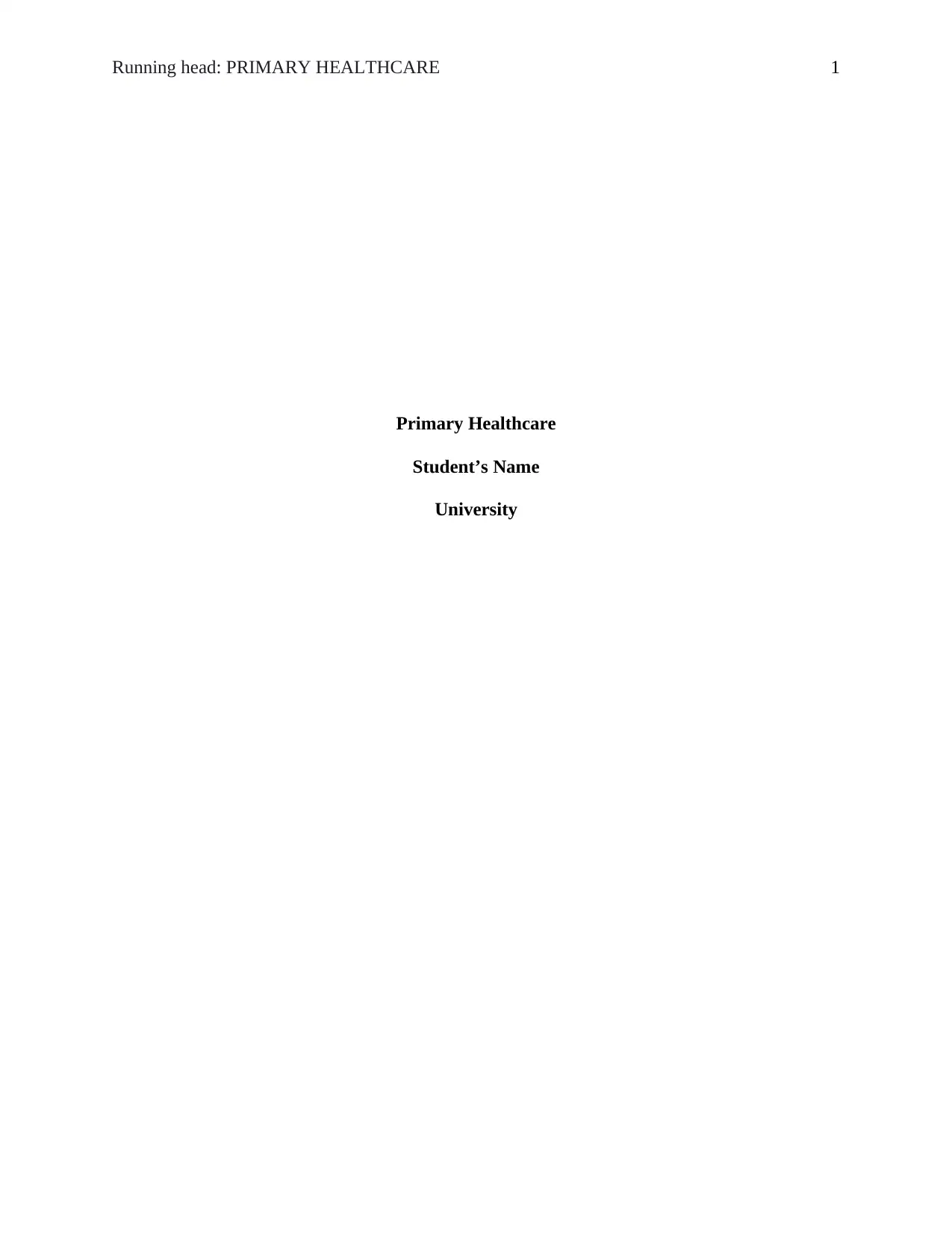
Running head: PRIMARY HEALTHCARE 1
Primary Healthcare
Student’s Name
University
Primary Healthcare
Student’s Name
University
Paraphrase This Document
Need a fresh take? Get an instant paraphrase of this document with our AI Paraphraser
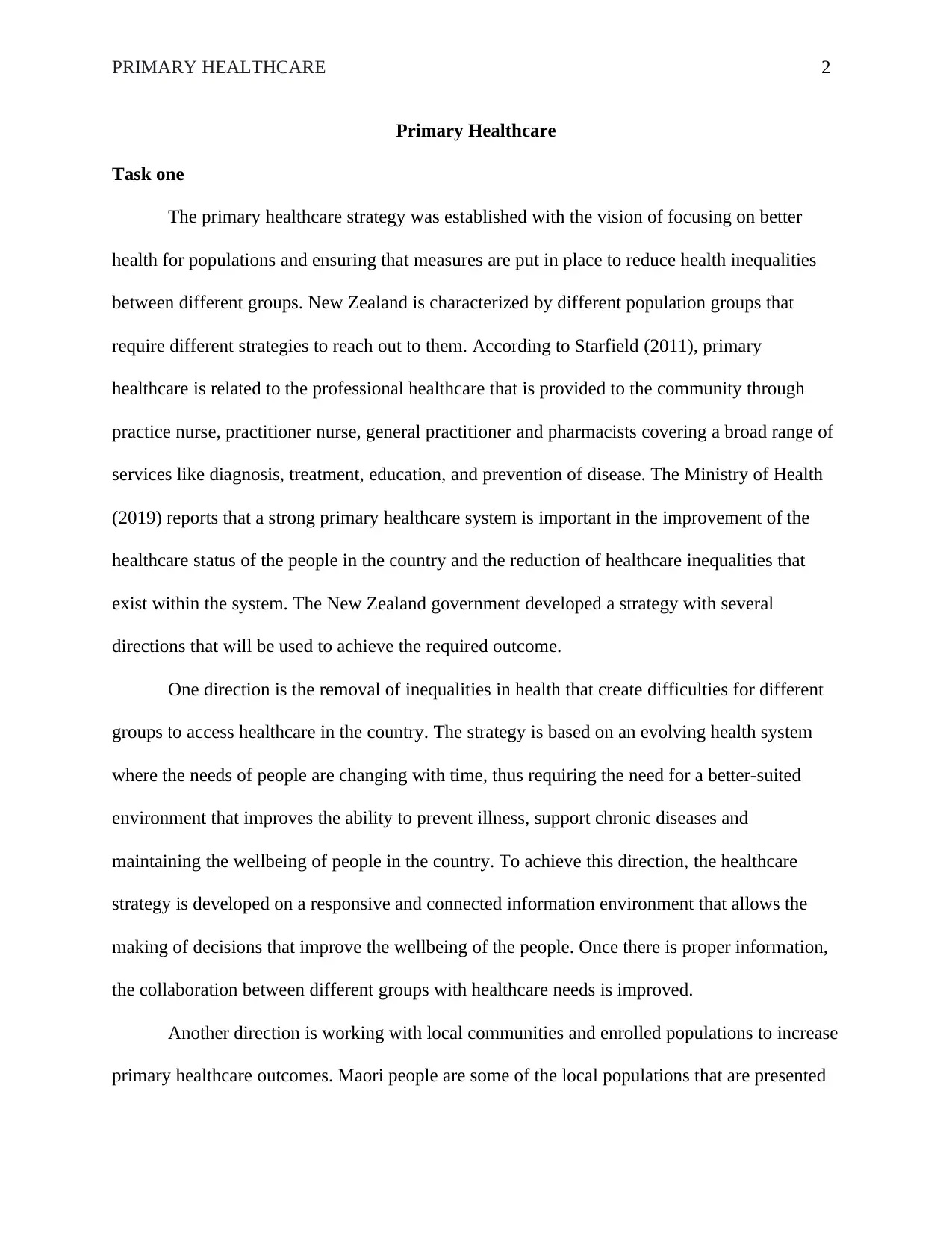
PRIMARY HEALTHCARE 2
Primary Healthcare
Task one
The primary healthcare strategy was established with the vision of focusing on better
health for populations and ensuring that measures are put in place to reduce health inequalities
between different groups. New Zealand is characterized by different population groups that
require different strategies to reach out to them. According to Starfield (2011), primary
healthcare is related to the professional healthcare that is provided to the community through
practice nurse, practitioner nurse, general practitioner and pharmacists covering a broad range of
services like diagnosis, treatment, education, and prevention of disease. The Ministry of Health
(2019) reports that a strong primary healthcare system is important in the improvement of the
healthcare status of the people in the country and the reduction of healthcare inequalities that
exist within the system. The New Zealand government developed a strategy with several
directions that will be used to achieve the required outcome.
One direction is the removal of inequalities in health that create difficulties for different
groups to access healthcare in the country. The strategy is based on an evolving health system
where the needs of people are changing with time, thus requiring the need for a better-suited
environment that improves the ability to prevent illness, support chronic diseases and
maintaining the wellbeing of people in the country. To achieve this direction, the healthcare
strategy is developed on a responsive and connected information environment that allows the
making of decisions that improve the wellbeing of the people. Once there is proper information,
the collaboration between different groups with healthcare needs is improved.
Another direction is working with local communities and enrolled populations to increase
primary healthcare outcomes. Maori people are some of the local populations that are presented
Primary Healthcare
Task one
The primary healthcare strategy was established with the vision of focusing on better
health for populations and ensuring that measures are put in place to reduce health inequalities
between different groups. New Zealand is characterized by different population groups that
require different strategies to reach out to them. According to Starfield (2011), primary
healthcare is related to the professional healthcare that is provided to the community through
practice nurse, practitioner nurse, general practitioner and pharmacists covering a broad range of
services like diagnosis, treatment, education, and prevention of disease. The Ministry of Health
(2019) reports that a strong primary healthcare system is important in the improvement of the
healthcare status of the people in the country and the reduction of healthcare inequalities that
exist within the system. The New Zealand government developed a strategy with several
directions that will be used to achieve the required outcome.
One direction is the removal of inequalities in health that create difficulties for different
groups to access healthcare in the country. The strategy is based on an evolving health system
where the needs of people are changing with time, thus requiring the need for a better-suited
environment that improves the ability to prevent illness, support chronic diseases and
maintaining the wellbeing of people in the country. To achieve this direction, the healthcare
strategy is developed on a responsive and connected information environment that allows the
making of decisions that improve the wellbeing of the people. Once there is proper information,
the collaboration between different groups with healthcare needs is improved.
Another direction is working with local communities and enrolled populations to increase
primary healthcare outcomes. Maori people are some of the local populations that are presented
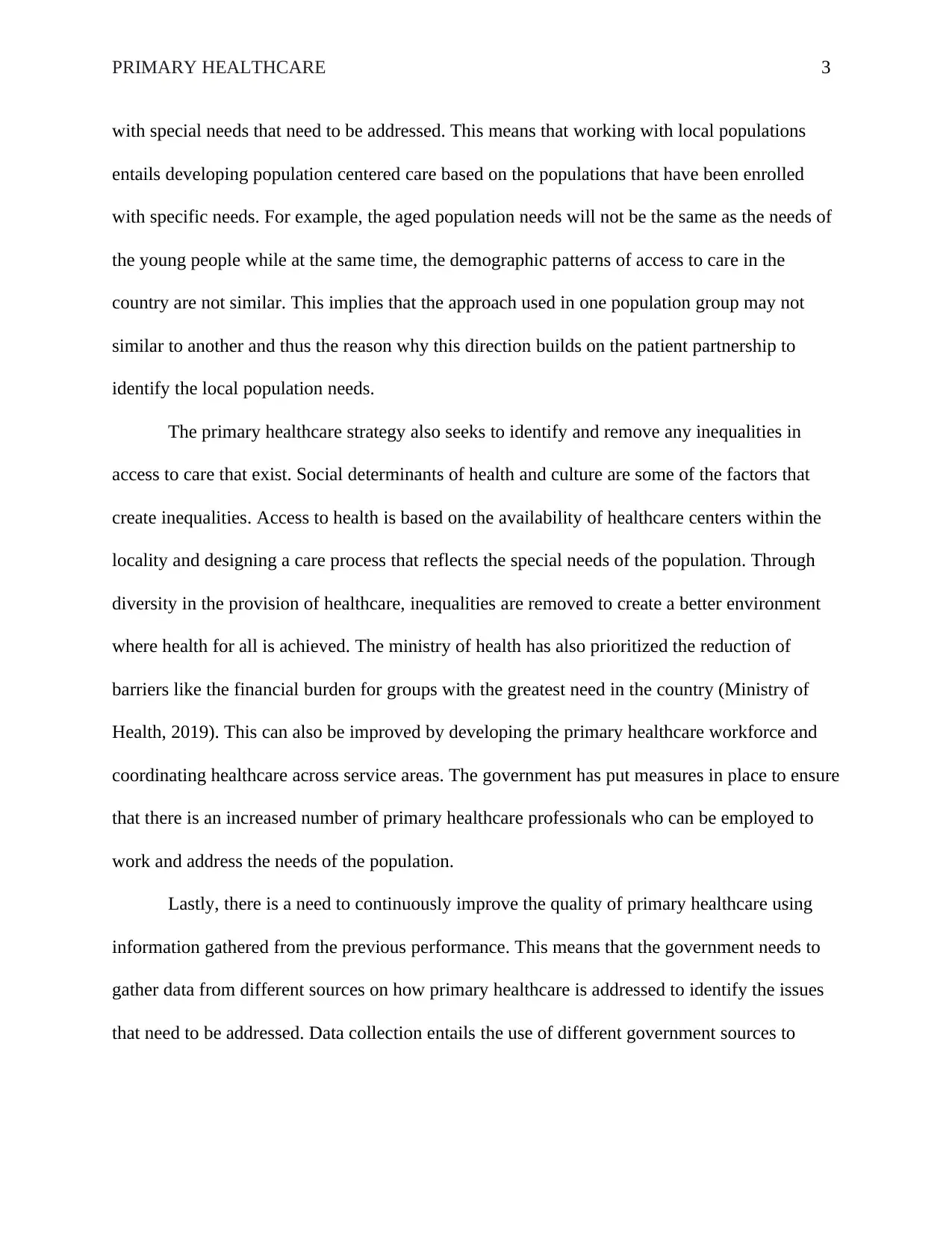
PRIMARY HEALTHCARE 3
with special needs that need to be addressed. This means that working with local populations
entails developing population centered care based on the populations that have been enrolled
with specific needs. For example, the aged population needs will not be the same as the needs of
the young people while at the same time, the demographic patterns of access to care in the
country are not similar. This implies that the approach used in one population group may not
similar to another and thus the reason why this direction builds on the patient partnership to
identify the local population needs.
The primary healthcare strategy also seeks to identify and remove any inequalities in
access to care that exist. Social determinants of health and culture are some of the factors that
create inequalities. Access to health is based on the availability of healthcare centers within the
locality and designing a care process that reflects the special needs of the population. Through
diversity in the provision of healthcare, inequalities are removed to create a better environment
where health for all is achieved. The ministry of health has also prioritized the reduction of
barriers like the financial burden for groups with the greatest need in the country (Ministry of
Health, 2019). This can also be improved by developing the primary healthcare workforce and
coordinating healthcare across service areas. The government has put measures in place to ensure
that there is an increased number of primary healthcare professionals who can be employed to
work and address the needs of the population.
Lastly, there is a need to continuously improve the quality of primary healthcare using
information gathered from the previous performance. This means that the government needs to
gather data from different sources on how primary healthcare is addressed to identify the issues
that need to be addressed. Data collection entails the use of different government sources to
with special needs that need to be addressed. This means that working with local populations
entails developing population centered care based on the populations that have been enrolled
with specific needs. For example, the aged population needs will not be the same as the needs of
the young people while at the same time, the demographic patterns of access to care in the
country are not similar. This implies that the approach used in one population group may not
similar to another and thus the reason why this direction builds on the patient partnership to
identify the local population needs.
The primary healthcare strategy also seeks to identify and remove any inequalities in
access to care that exist. Social determinants of health and culture are some of the factors that
create inequalities. Access to health is based on the availability of healthcare centers within the
locality and designing a care process that reflects the special needs of the population. Through
diversity in the provision of healthcare, inequalities are removed to create a better environment
where health for all is achieved. The ministry of health has also prioritized the reduction of
barriers like the financial burden for groups with the greatest need in the country (Ministry of
Health, 2019). This can also be improved by developing the primary healthcare workforce and
coordinating healthcare across service areas. The government has put measures in place to ensure
that there is an increased number of primary healthcare professionals who can be employed to
work and address the needs of the population.
Lastly, there is a need to continuously improve the quality of primary healthcare using
information gathered from the previous performance. This means that the government needs to
gather data from different sources on how primary healthcare is addressed to identify the issues
that need to be addressed. Data collection entails the use of different government sources to
⊘ This is a preview!⊘
Do you want full access?
Subscribe today to unlock all pages.

Trusted by 1+ million students worldwide
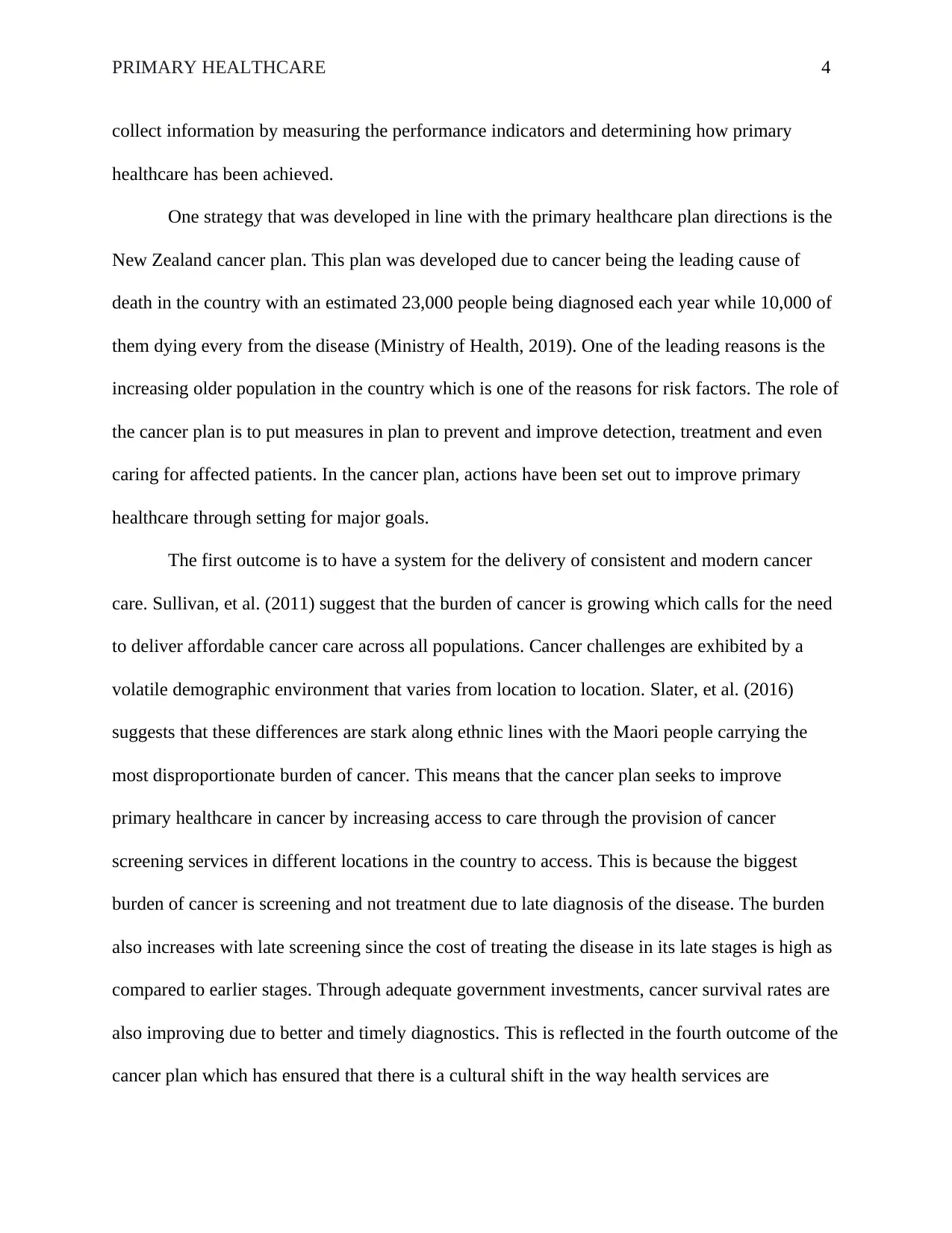
PRIMARY HEALTHCARE 4
collect information by measuring the performance indicators and determining how primary
healthcare has been achieved.
One strategy that was developed in line with the primary healthcare plan directions is the
New Zealand cancer plan. This plan was developed due to cancer being the leading cause of
death in the country with an estimated 23,000 people being diagnosed each year while 10,000 of
them dying every from the disease (Ministry of Health, 2019). One of the leading reasons is the
increasing older population in the country which is one of the reasons for risk factors. The role of
the cancer plan is to put measures in plan to prevent and improve detection, treatment and even
caring for affected patients. In the cancer plan, actions have been set out to improve primary
healthcare through setting for major goals.
The first outcome is to have a system for the delivery of consistent and modern cancer
care. Sullivan, et al. (2011) suggest that the burden of cancer is growing which calls for the need
to deliver affordable cancer care across all populations. Cancer challenges are exhibited by a
volatile demographic environment that varies from location to location. Slater, et al. (2016)
suggests that these differences are stark along ethnic lines with the Maori people carrying the
most disproportionate burden of cancer. This means that the cancer plan seeks to improve
primary healthcare in cancer by increasing access to care through the provision of cancer
screening services in different locations in the country to access. This is because the biggest
burden of cancer is screening and not treatment due to late diagnosis of the disease. The burden
also increases with late screening since the cost of treating the disease in its late stages is high as
compared to earlier stages. Through adequate government investments, cancer survival rates are
also improving due to better and timely diagnostics. This is reflected in the fourth outcome of the
cancer plan which has ensured that there is a cultural shift in the way health services are
collect information by measuring the performance indicators and determining how primary
healthcare has been achieved.
One strategy that was developed in line with the primary healthcare plan directions is the
New Zealand cancer plan. This plan was developed due to cancer being the leading cause of
death in the country with an estimated 23,000 people being diagnosed each year while 10,000 of
them dying every from the disease (Ministry of Health, 2019). One of the leading reasons is the
increasing older population in the country which is one of the reasons for risk factors. The role of
the cancer plan is to put measures in plan to prevent and improve detection, treatment and even
caring for affected patients. In the cancer plan, actions have been set out to improve primary
healthcare through setting for major goals.
The first outcome is to have a system for the delivery of consistent and modern cancer
care. Sullivan, et al. (2011) suggest that the burden of cancer is growing which calls for the need
to deliver affordable cancer care across all populations. Cancer challenges are exhibited by a
volatile demographic environment that varies from location to location. Slater, et al. (2016)
suggests that these differences are stark along ethnic lines with the Maori people carrying the
most disproportionate burden of cancer. This means that the cancer plan seeks to improve
primary healthcare in cancer by increasing access to care through the provision of cancer
screening services in different locations in the country to access. This is because the biggest
burden of cancer is screening and not treatment due to late diagnosis of the disease. The burden
also increases with late screening since the cost of treating the disease in its late stages is high as
compared to earlier stages. Through adequate government investments, cancer survival rates are
also improving due to better and timely diagnostics. This is reflected in the fourth outcome of the
cancer plan which has ensured that there is a cultural shift in the way health services are
Paraphrase This Document
Need a fresh take? Get an instant paraphrase of this document with our AI Paraphraser
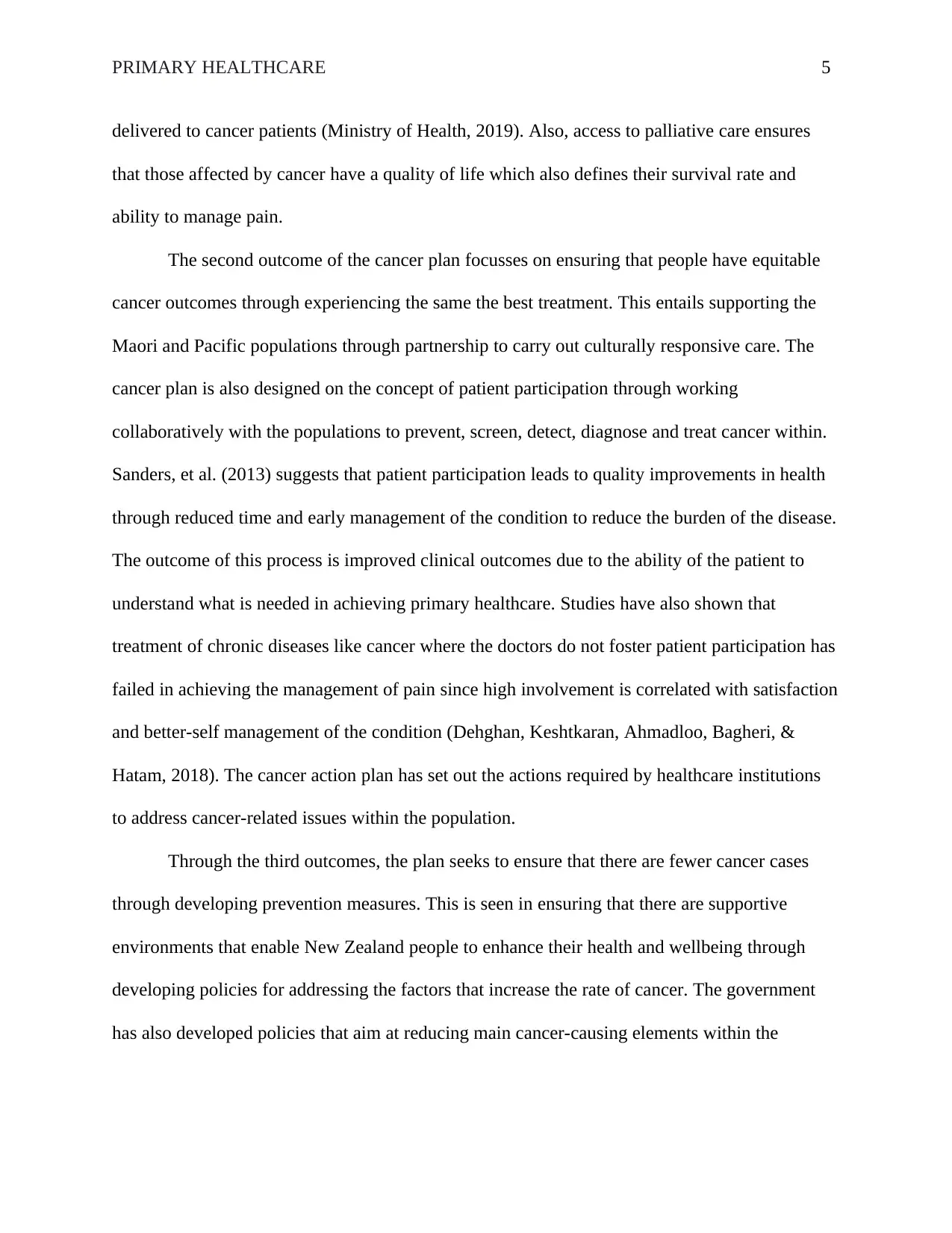
PRIMARY HEALTHCARE 5
delivered to cancer patients (Ministry of Health, 2019). Also, access to palliative care ensures
that those affected by cancer have a quality of life which also defines their survival rate and
ability to manage pain.
The second outcome of the cancer plan focusses on ensuring that people have equitable
cancer outcomes through experiencing the same the best treatment. This entails supporting the
Maori and Pacific populations through partnership to carry out culturally responsive care. The
cancer plan is also designed on the concept of patient participation through working
collaboratively with the populations to prevent, screen, detect, diagnose and treat cancer within.
Sanders, et al. (2013) suggests that patient participation leads to quality improvements in health
through reduced time and early management of the condition to reduce the burden of the disease.
The outcome of this process is improved clinical outcomes due to the ability of the patient to
understand what is needed in achieving primary healthcare. Studies have also shown that
treatment of chronic diseases like cancer where the doctors do not foster patient participation has
failed in achieving the management of pain since high involvement is correlated with satisfaction
and better-self management of the condition (Dehghan, Keshtkaran, Ahmadloo, Bagheri, &
Hatam, 2018). The cancer action plan has set out the actions required by healthcare institutions
to address cancer-related issues within the population.
Through the third outcomes, the plan seeks to ensure that there are fewer cancer cases
through developing prevention measures. This is seen in ensuring that there are supportive
environments that enable New Zealand people to enhance their health and wellbeing through
developing policies for addressing the factors that increase the rate of cancer. The government
has also developed policies that aim at reducing main cancer-causing elements within the
delivered to cancer patients (Ministry of Health, 2019). Also, access to palliative care ensures
that those affected by cancer have a quality of life which also defines their survival rate and
ability to manage pain.
The second outcome of the cancer plan focusses on ensuring that people have equitable
cancer outcomes through experiencing the same the best treatment. This entails supporting the
Maori and Pacific populations through partnership to carry out culturally responsive care. The
cancer plan is also designed on the concept of patient participation through working
collaboratively with the populations to prevent, screen, detect, diagnose and treat cancer within.
Sanders, et al. (2013) suggests that patient participation leads to quality improvements in health
through reduced time and early management of the condition to reduce the burden of the disease.
The outcome of this process is improved clinical outcomes due to the ability of the patient to
understand what is needed in achieving primary healthcare. Studies have also shown that
treatment of chronic diseases like cancer where the doctors do not foster patient participation has
failed in achieving the management of pain since high involvement is correlated with satisfaction
and better-self management of the condition (Dehghan, Keshtkaran, Ahmadloo, Bagheri, &
Hatam, 2018). The cancer action plan has set out the actions required by healthcare institutions
to address cancer-related issues within the population.
Through the third outcomes, the plan seeks to ensure that there are fewer cancer cases
through developing prevention measures. This is seen in ensuring that there are supportive
environments that enable New Zealand people to enhance their health and wellbeing through
developing policies for addressing the factors that increase the rate of cancer. The government
has also developed policies that aim at reducing main cancer-causing elements within the
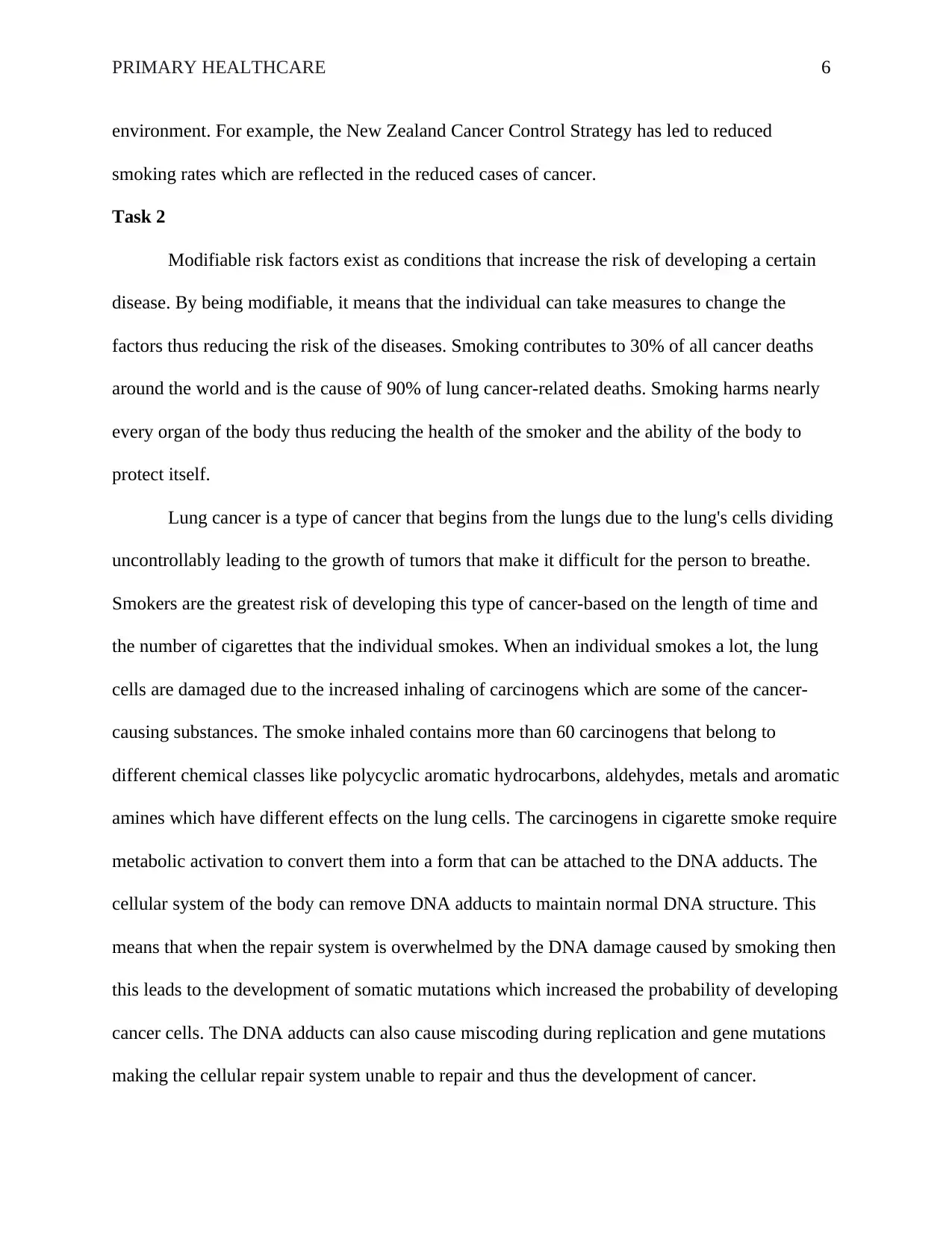
PRIMARY HEALTHCARE 6
environment. For example, the New Zealand Cancer Control Strategy has led to reduced
smoking rates which are reflected in the reduced cases of cancer.
Task 2
Modifiable risk factors exist as conditions that increase the risk of developing a certain
disease. By being modifiable, it means that the individual can take measures to change the
factors thus reducing the risk of the diseases. Smoking contributes to 30% of all cancer deaths
around the world and is the cause of 90% of lung cancer-related deaths. Smoking harms nearly
every organ of the body thus reducing the health of the smoker and the ability of the body to
protect itself.
Lung cancer is a type of cancer that begins from the lungs due to the lung's cells dividing
uncontrollably leading to the growth of tumors that make it difficult for the person to breathe.
Smokers are the greatest risk of developing this type of cancer-based on the length of time and
the number of cigarettes that the individual smokes. When an individual smokes a lot, the lung
cells are damaged due to the increased inhaling of carcinogens which are some of the cancer-
causing substances. The smoke inhaled contains more than 60 carcinogens that belong to
different chemical classes like polycyclic aromatic hydrocarbons, aldehydes, metals and aromatic
amines which have different effects on the lung cells. The carcinogens in cigarette smoke require
metabolic activation to convert them into a form that can be attached to the DNA adducts. The
cellular system of the body can remove DNA adducts to maintain normal DNA structure. This
means that when the repair system is overwhelmed by the DNA damage caused by smoking then
this leads to the development of somatic mutations which increased the probability of developing
cancer cells. The DNA adducts can also cause miscoding during replication and gene mutations
making the cellular repair system unable to repair and thus the development of cancer.
environment. For example, the New Zealand Cancer Control Strategy has led to reduced
smoking rates which are reflected in the reduced cases of cancer.
Task 2
Modifiable risk factors exist as conditions that increase the risk of developing a certain
disease. By being modifiable, it means that the individual can take measures to change the
factors thus reducing the risk of the diseases. Smoking contributes to 30% of all cancer deaths
around the world and is the cause of 90% of lung cancer-related deaths. Smoking harms nearly
every organ of the body thus reducing the health of the smoker and the ability of the body to
protect itself.
Lung cancer is a type of cancer that begins from the lungs due to the lung's cells dividing
uncontrollably leading to the growth of tumors that make it difficult for the person to breathe.
Smokers are the greatest risk of developing this type of cancer-based on the length of time and
the number of cigarettes that the individual smokes. When an individual smokes a lot, the lung
cells are damaged due to the increased inhaling of carcinogens which are some of the cancer-
causing substances. The smoke inhaled contains more than 60 carcinogens that belong to
different chemical classes like polycyclic aromatic hydrocarbons, aldehydes, metals and aromatic
amines which have different effects on the lung cells. The carcinogens in cigarette smoke require
metabolic activation to convert them into a form that can be attached to the DNA adducts. The
cellular system of the body can remove DNA adducts to maintain normal DNA structure. This
means that when the repair system is overwhelmed by the DNA damage caused by smoking then
this leads to the development of somatic mutations which increased the probability of developing
cancer cells. The DNA adducts can also cause miscoding during replication and gene mutations
making the cellular repair system unable to repair and thus the development of cancer.
⊘ This is a preview!⊘
Do you want full access?
Subscribe today to unlock all pages.

Trusted by 1+ million students worldwide
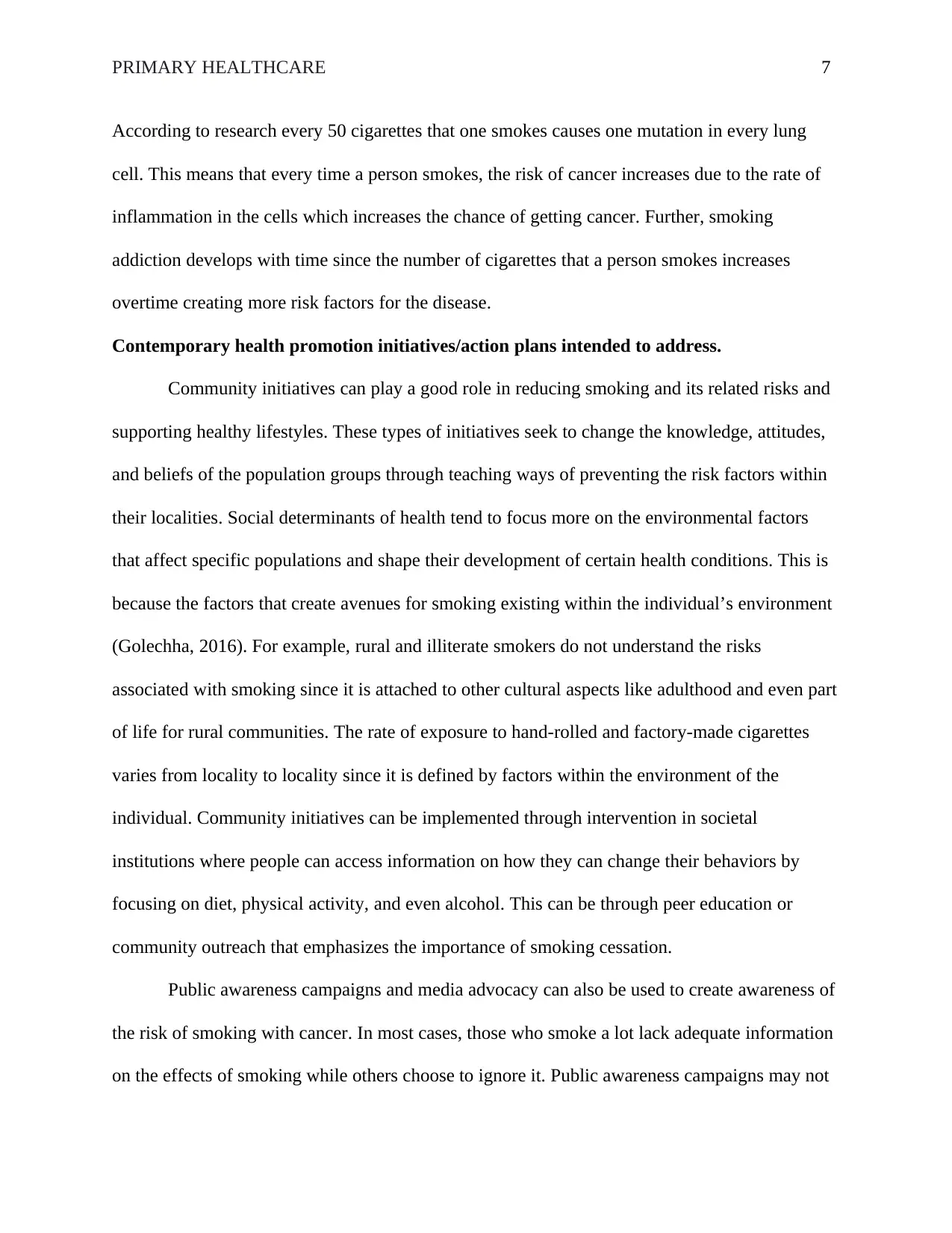
PRIMARY HEALTHCARE 7
According to research every 50 cigarettes that one smokes causes one mutation in every lung
cell. This means that every time a person smokes, the risk of cancer increases due to the rate of
inflammation in the cells which increases the chance of getting cancer. Further, smoking
addiction develops with time since the number of cigarettes that a person smokes increases
overtime creating more risk factors for the disease.
Contemporary health promotion initiatives/action plans intended to address.
Community initiatives can play a good role in reducing smoking and its related risks and
supporting healthy lifestyles. These types of initiatives seek to change the knowledge, attitudes,
and beliefs of the population groups through teaching ways of preventing the risk factors within
their localities. Social determinants of health tend to focus more on the environmental factors
that affect specific populations and shape their development of certain health conditions. This is
because the factors that create avenues for smoking existing within the individual’s environment
(Golechha, 2016). For example, rural and illiterate smokers do not understand the risks
associated with smoking since it is attached to other cultural aspects like adulthood and even part
of life for rural communities. The rate of exposure to hand-rolled and factory-made cigarettes
varies from locality to locality since it is defined by factors within the environment of the
individual. Community initiatives can be implemented through intervention in societal
institutions where people can access information on how they can change their behaviors by
focusing on diet, physical activity, and even alcohol. This can be through peer education or
community outreach that emphasizes the importance of smoking cessation.
Public awareness campaigns and media advocacy can also be used to create awareness of
the risk of smoking with cancer. In most cases, those who smoke a lot lack adequate information
on the effects of smoking while others choose to ignore it. Public awareness campaigns may not
According to research every 50 cigarettes that one smokes causes one mutation in every lung
cell. This means that every time a person smokes, the risk of cancer increases due to the rate of
inflammation in the cells which increases the chance of getting cancer. Further, smoking
addiction develops with time since the number of cigarettes that a person smokes increases
overtime creating more risk factors for the disease.
Contemporary health promotion initiatives/action plans intended to address.
Community initiatives can play a good role in reducing smoking and its related risks and
supporting healthy lifestyles. These types of initiatives seek to change the knowledge, attitudes,
and beliefs of the population groups through teaching ways of preventing the risk factors within
their localities. Social determinants of health tend to focus more on the environmental factors
that affect specific populations and shape their development of certain health conditions. This is
because the factors that create avenues for smoking existing within the individual’s environment
(Golechha, 2016). For example, rural and illiterate smokers do not understand the risks
associated with smoking since it is attached to other cultural aspects like adulthood and even part
of life for rural communities. The rate of exposure to hand-rolled and factory-made cigarettes
varies from locality to locality since it is defined by factors within the environment of the
individual. Community initiatives can be implemented through intervention in societal
institutions where people can access information on how they can change their behaviors by
focusing on diet, physical activity, and even alcohol. This can be through peer education or
community outreach that emphasizes the importance of smoking cessation.
Public awareness campaigns and media advocacy can also be used to create awareness of
the risk of smoking with cancer. In most cases, those who smoke a lot lack adequate information
on the effects of smoking while others choose to ignore it. Public awareness campaigns may not
Paraphrase This Document
Need a fresh take? Get an instant paraphrase of this document with our AI Paraphraser
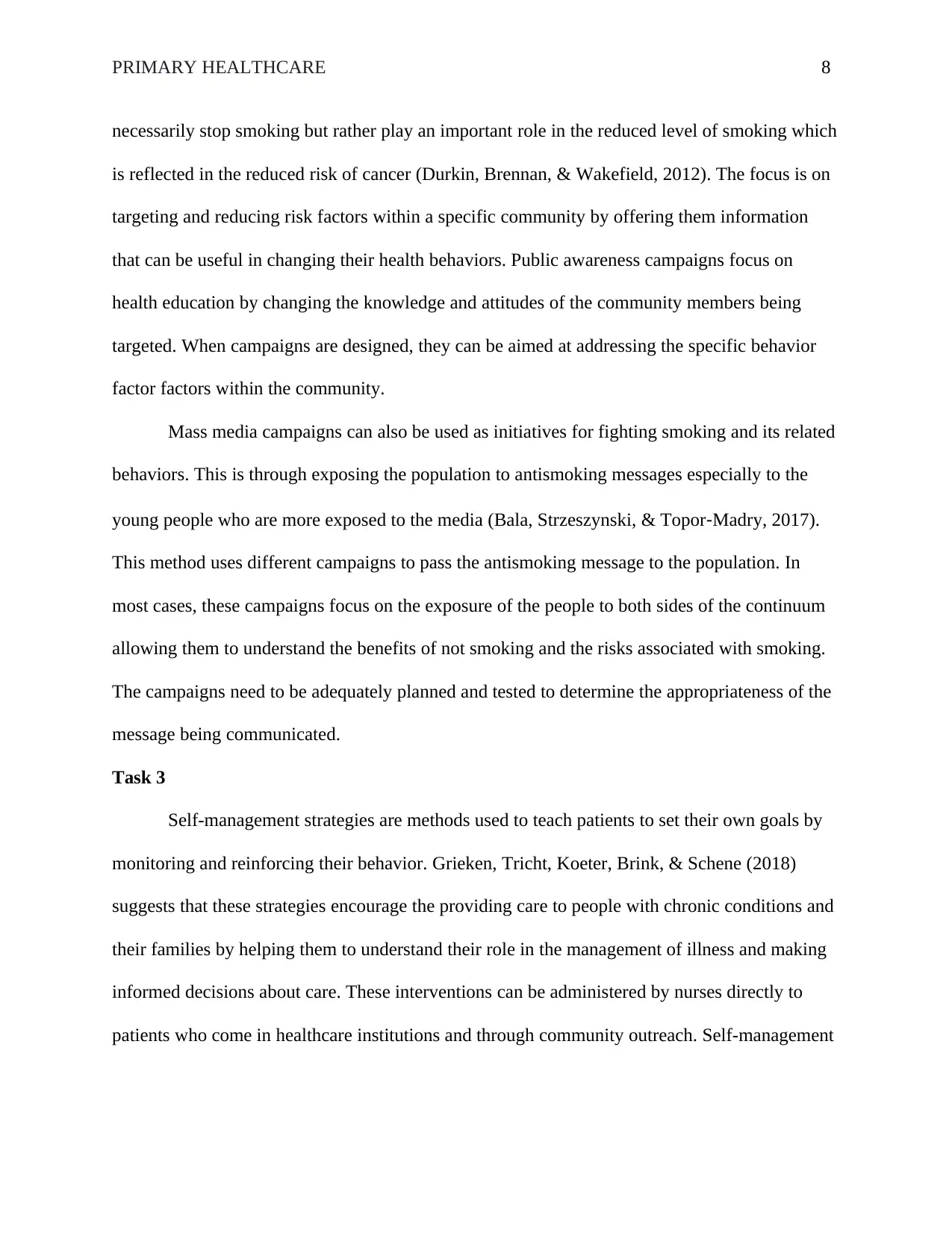
PRIMARY HEALTHCARE 8
necessarily stop smoking but rather play an important role in the reduced level of smoking which
is reflected in the reduced risk of cancer (Durkin, Brennan, & Wakefield, 2012). The focus is on
targeting and reducing risk factors within a specific community by offering them information
that can be useful in changing their health behaviors. Public awareness campaigns focus on
health education by changing the knowledge and attitudes of the community members being
targeted. When campaigns are designed, they can be aimed at addressing the specific behavior
factor factors within the community.
Mass media campaigns can also be used as initiatives for fighting smoking and its related
behaviors. This is through exposing the population to antismoking messages especially to the
young people who are more exposed to the media (Bala, Strzeszynski, & Topor‐Madry, 2017).
This method uses different campaigns to pass the antismoking message to the population. In
most cases, these campaigns focus on the exposure of the people to both sides of the continuum
allowing them to understand the benefits of not smoking and the risks associated with smoking.
The campaigns need to be adequately planned and tested to determine the appropriateness of the
message being communicated.
Task 3
Self-management strategies are methods used to teach patients to set their own goals by
monitoring and reinforcing their behavior. Grieken, Tricht, Koeter, Brink, & Schene (2018)
suggests that these strategies encourage the providing care to people with chronic conditions and
their families by helping them to understand their role in the management of illness and making
informed decisions about care. These interventions can be administered by nurses directly to
patients who come in healthcare institutions and through community outreach. Self-management
necessarily stop smoking but rather play an important role in the reduced level of smoking which
is reflected in the reduced risk of cancer (Durkin, Brennan, & Wakefield, 2012). The focus is on
targeting and reducing risk factors within a specific community by offering them information
that can be useful in changing their health behaviors. Public awareness campaigns focus on
health education by changing the knowledge and attitudes of the community members being
targeted. When campaigns are designed, they can be aimed at addressing the specific behavior
factor factors within the community.
Mass media campaigns can also be used as initiatives for fighting smoking and its related
behaviors. This is through exposing the population to antismoking messages especially to the
young people who are more exposed to the media (Bala, Strzeszynski, & Topor‐Madry, 2017).
This method uses different campaigns to pass the antismoking message to the population. In
most cases, these campaigns focus on the exposure of the people to both sides of the continuum
allowing them to understand the benefits of not smoking and the risks associated with smoking.
The campaigns need to be adequately planned and tested to determine the appropriateness of the
message being communicated.
Task 3
Self-management strategies are methods used to teach patients to set their own goals by
monitoring and reinforcing their behavior. Grieken, Tricht, Koeter, Brink, & Schene (2018)
suggests that these strategies encourage the providing care to people with chronic conditions and
their families by helping them to understand their role in the management of illness and making
informed decisions about care. These interventions can be administered by nurses directly to
patients who come in healthcare institutions and through community outreach. Self-management
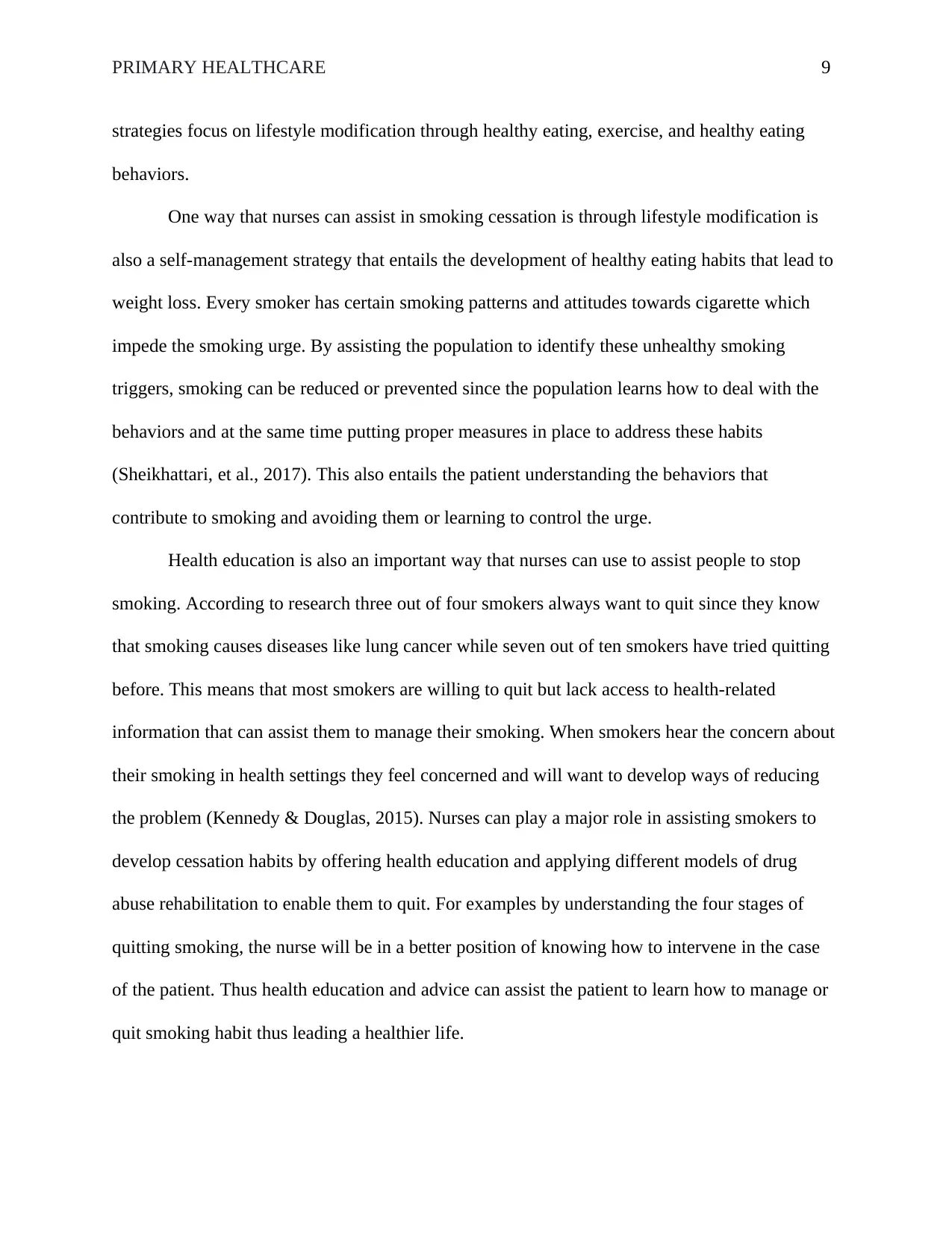
PRIMARY HEALTHCARE 9
strategies focus on lifestyle modification through healthy eating, exercise, and healthy eating
behaviors.
One way that nurses can assist in smoking cessation is through lifestyle modification is
also a self-management strategy that entails the development of healthy eating habits that lead to
weight loss. Every smoker has certain smoking patterns and attitudes towards cigarette which
impede the smoking urge. By assisting the population to identify these unhealthy smoking
triggers, smoking can be reduced or prevented since the population learns how to deal with the
behaviors and at the same time putting proper measures in place to address these habits
(Sheikhattari, et al., 2017). This also entails the patient understanding the behaviors that
contribute to smoking and avoiding them or learning to control the urge.
Health education is also an important way that nurses can use to assist people to stop
smoking. According to research three out of four smokers always want to quit since they know
that smoking causes diseases like lung cancer while seven out of ten smokers have tried quitting
before. This means that most smokers are willing to quit but lack access to health-related
information that can assist them to manage their smoking. When smokers hear the concern about
their smoking in health settings they feel concerned and will want to develop ways of reducing
the problem (Kennedy & Douglas, 2015). Nurses can play a major role in assisting smokers to
develop cessation habits by offering health education and applying different models of drug
abuse rehabilitation to enable them to quit. For examples by understanding the four stages of
quitting smoking, the nurse will be in a better position of knowing how to intervene in the case
of the patient. Thus health education and advice can assist the patient to learn how to manage or
quit smoking habit thus leading a healthier life.
strategies focus on lifestyle modification through healthy eating, exercise, and healthy eating
behaviors.
One way that nurses can assist in smoking cessation is through lifestyle modification is
also a self-management strategy that entails the development of healthy eating habits that lead to
weight loss. Every smoker has certain smoking patterns and attitudes towards cigarette which
impede the smoking urge. By assisting the population to identify these unhealthy smoking
triggers, smoking can be reduced or prevented since the population learns how to deal with the
behaviors and at the same time putting proper measures in place to address these habits
(Sheikhattari, et al., 2017). This also entails the patient understanding the behaviors that
contribute to smoking and avoiding them or learning to control the urge.
Health education is also an important way that nurses can use to assist people to stop
smoking. According to research three out of four smokers always want to quit since they know
that smoking causes diseases like lung cancer while seven out of ten smokers have tried quitting
before. This means that most smokers are willing to quit but lack access to health-related
information that can assist them to manage their smoking. When smokers hear the concern about
their smoking in health settings they feel concerned and will want to develop ways of reducing
the problem (Kennedy & Douglas, 2015). Nurses can play a major role in assisting smokers to
develop cessation habits by offering health education and applying different models of drug
abuse rehabilitation to enable them to quit. For examples by understanding the four stages of
quitting smoking, the nurse will be in a better position of knowing how to intervene in the case
of the patient. Thus health education and advice can assist the patient to learn how to manage or
quit smoking habit thus leading a healthier life.
⊘ This is a preview!⊘
Do you want full access?
Subscribe today to unlock all pages.

Trusted by 1+ million students worldwide
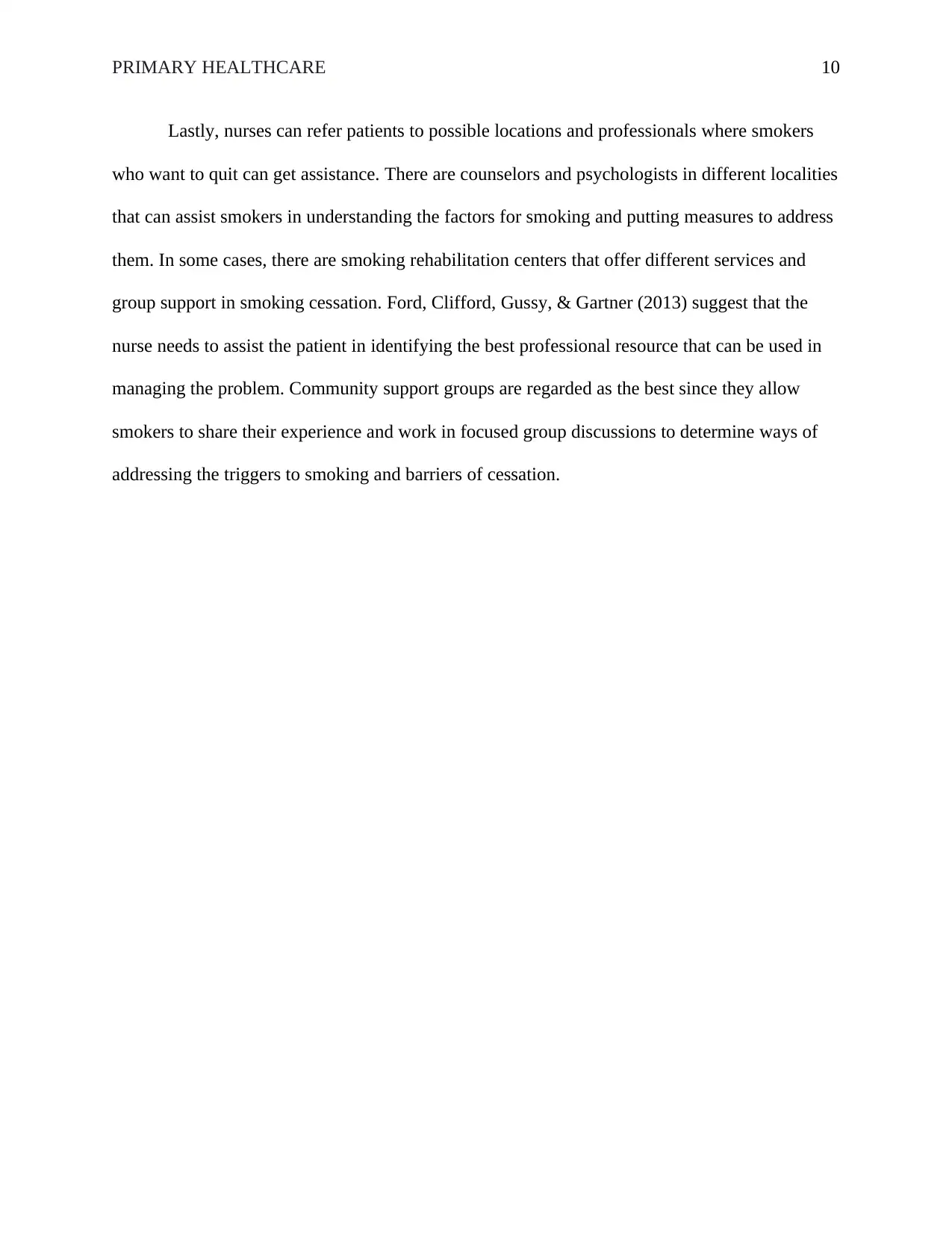
PRIMARY HEALTHCARE 10
Lastly, nurses can refer patients to possible locations and professionals where smokers
who want to quit can get assistance. There are counselors and psychologists in different localities
that can assist smokers in understanding the factors for smoking and putting measures to address
them. In some cases, there are smoking rehabilitation centers that offer different services and
group support in smoking cessation. Ford, Clifford, Gussy, & Gartner (2013) suggest that the
nurse needs to assist the patient in identifying the best professional resource that can be used in
managing the problem. Community support groups are regarded as the best since they allow
smokers to share their experience and work in focused group discussions to determine ways of
addressing the triggers to smoking and barriers of cessation.
Lastly, nurses can refer patients to possible locations and professionals where smokers
who want to quit can get assistance. There are counselors and psychologists in different localities
that can assist smokers in understanding the factors for smoking and putting measures to address
them. In some cases, there are smoking rehabilitation centers that offer different services and
group support in smoking cessation. Ford, Clifford, Gussy, & Gartner (2013) suggest that the
nurse needs to assist the patient in identifying the best professional resource that can be used in
managing the problem. Community support groups are regarded as the best since they allow
smokers to share their experience and work in focused group discussions to determine ways of
addressing the triggers to smoking and barriers of cessation.
Paraphrase This Document
Need a fresh take? Get an instant paraphrase of this document with our AI Paraphraser
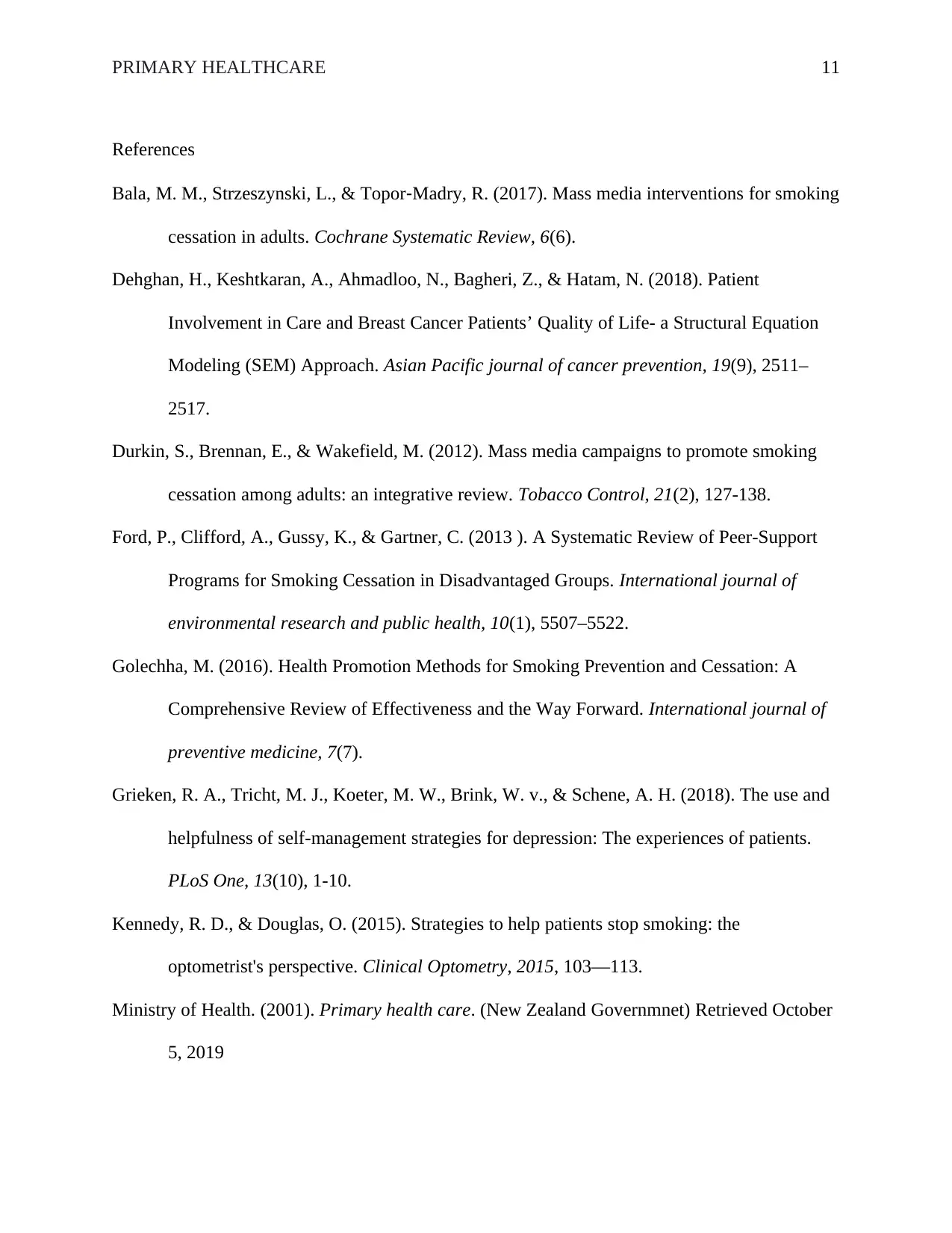
PRIMARY HEALTHCARE 11
References
Bala, M. M., Strzeszynski, L., & Topor‐Madry, R. (2017). Mass media interventions for smoking
cessation in adults. Cochrane Systematic Review, 6(6).
Dehghan, H., Keshtkaran, A., Ahmadloo, N., Bagheri, Z., & Hatam, N. (2018). Patient
Involvement in Care and Breast Cancer Patients’ Quality of Life- a Structural Equation
Modeling (SEM) Approach. Asian Pacific journal of cancer prevention, 19(9), 2511–
2517.
Durkin, S., Brennan, E., & Wakefield, M. (2012). Mass media campaigns to promote smoking
cessation among adults: an integrative review. Tobacco Control, 21(2), 127-138.
Ford, P., Clifford, A., Gussy, K., & Gartner, C. (2013 ). A Systematic Review of Peer-Support
Programs for Smoking Cessation in Disadvantaged Groups. International journal of
environmental research and public health, 10(1), 5507–5522.
Golechha, M. (2016). Health Promotion Methods for Smoking Prevention and Cessation: A
Comprehensive Review of Effectiveness and the Way Forward. International journal of
preventive medicine, 7(7).
Grieken, R. A., Tricht, M. J., Koeter, M. W., Brink, W. v., & Schene, A. H. (2018). The use and
helpfulness of self-management strategies for depression: The experiences of patients.
PLoS One, 13(10), 1-10.
Kennedy, R. D., & Douglas, O. (2015). Strategies to help patients stop smoking: the
optometrist's perspective. Clinical Optometry, 2015, 103—113.
Ministry of Health. (2001). Primary health care. (New Zealand Governmnet) Retrieved October
5, 2019
References
Bala, M. M., Strzeszynski, L., & Topor‐Madry, R. (2017). Mass media interventions for smoking
cessation in adults. Cochrane Systematic Review, 6(6).
Dehghan, H., Keshtkaran, A., Ahmadloo, N., Bagheri, Z., & Hatam, N. (2018). Patient
Involvement in Care and Breast Cancer Patients’ Quality of Life- a Structural Equation
Modeling (SEM) Approach. Asian Pacific journal of cancer prevention, 19(9), 2511–
2517.
Durkin, S., Brennan, E., & Wakefield, M. (2012). Mass media campaigns to promote smoking
cessation among adults: an integrative review. Tobacco Control, 21(2), 127-138.
Ford, P., Clifford, A., Gussy, K., & Gartner, C. (2013 ). A Systematic Review of Peer-Support
Programs for Smoking Cessation in Disadvantaged Groups. International journal of
environmental research and public health, 10(1), 5507–5522.
Golechha, M. (2016). Health Promotion Methods for Smoking Prevention and Cessation: A
Comprehensive Review of Effectiveness and the Way Forward. International journal of
preventive medicine, 7(7).
Grieken, R. A., Tricht, M. J., Koeter, M. W., Brink, W. v., & Schene, A. H. (2018). The use and
helpfulness of self-management strategies for depression: The experiences of patients.
PLoS One, 13(10), 1-10.
Kennedy, R. D., & Douglas, O. (2015). Strategies to help patients stop smoking: the
optometrist's perspective. Clinical Optometry, 2015, 103—113.
Ministry of Health. (2001). Primary health care. (New Zealand Governmnet) Retrieved October
5, 2019
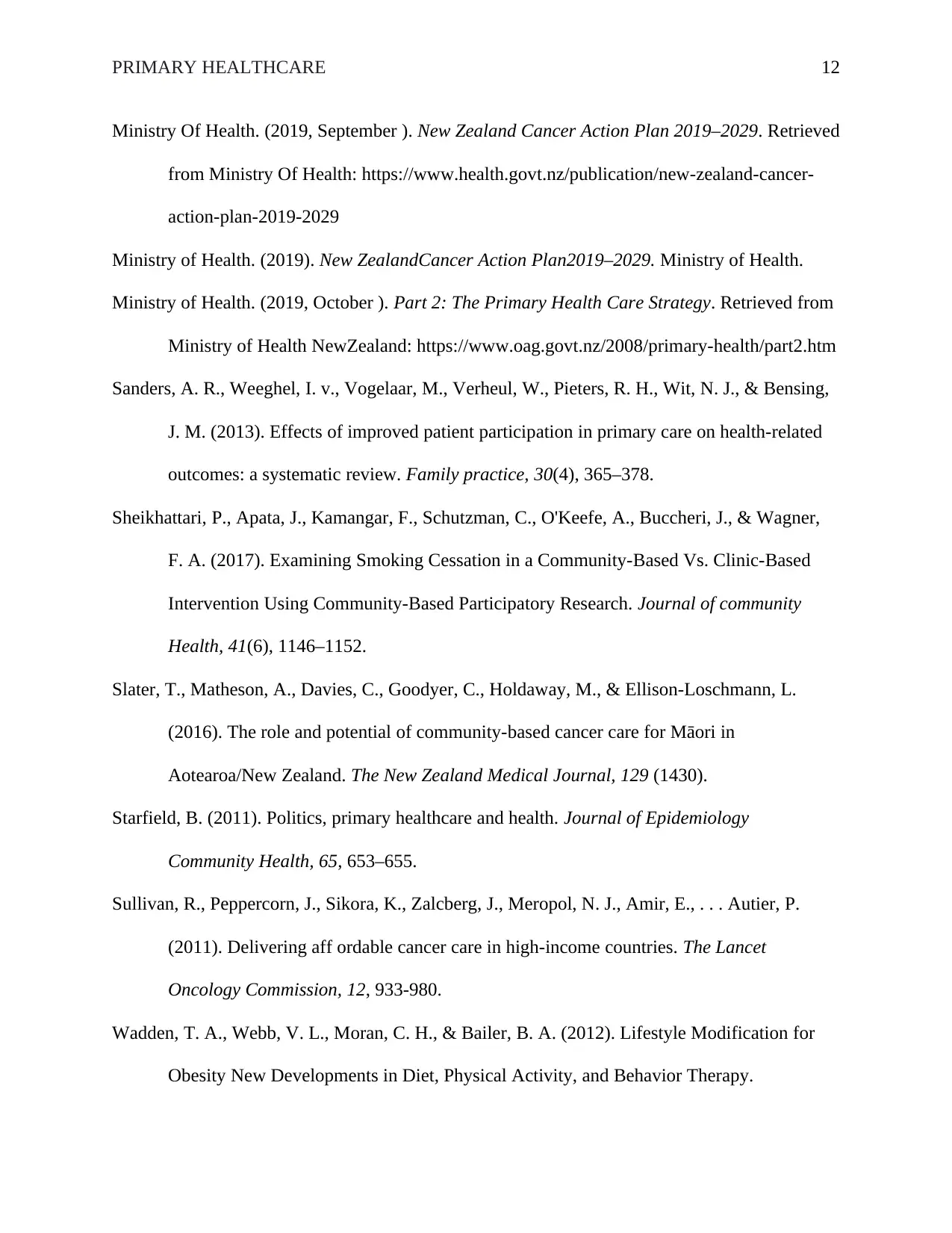
PRIMARY HEALTHCARE 12
Ministry Of Health. (2019, September ). New Zealand Cancer Action Plan 2019–2029. Retrieved
from Ministry Of Health: https://www.health.govt.nz/publication/new-zealand-cancer-
action-plan-2019-2029
Ministry of Health. (2019). New ZealandCancer Action Plan2019–2029. Ministry of Health.
Ministry of Health. (2019, October ). Part 2: The Primary Health Care Strategy. Retrieved from
Ministry of Health NewZealand: https://www.oag.govt.nz/2008/primary-health/part2.htm
Sanders, A. R., Weeghel, I. v., Vogelaar, M., Verheul, W., Pieters, R. H., Wit, N. J., & Bensing,
J. M. (2013). Effects of improved patient participation in primary care on health-related
outcomes: a systematic review. Family practice, 30(4), 365–378.
Sheikhattari, P., Apata, J., Kamangar, F., Schutzman, C., O'Keefe, A., Buccheri, J., & Wagner,
F. A. (2017). Examining Smoking Cessation in a Community-Based Vs. Clinic-Based
Intervention Using Community-Based Participatory Research. Journal of community
Health, 41(6), 1146–1152.
Slater, T., Matheson, A., Davies, C., Goodyer, C., Holdaway, M., & Ellison-Loschmann, L.
(2016). The role and potential of community-based cancer care for Māori in
Aotearoa/New Zealand. The New Zealand Medical Journal, 129 (1430).
Starfield, B. (2011). Politics, primary healthcare and health. Journal of Epidemiology
Community Health, 65, 653–655.
Sullivan, R., Peppercorn, J., Sikora, K., Zalcberg, J., Meropol, N. J., Amir, E., . . . Autier, P.
(2011). Delivering aff ordable cancer care in high-income countries. The Lancet
Oncology Commission, 12, 933-980.
Wadden, T. A., Webb, V. L., Moran, C. H., & Bailer, B. A. (2012). Lifestyle Modification for
Obesity New Developments in Diet, Physical Activity, and Behavior Therapy.
Ministry Of Health. (2019, September ). New Zealand Cancer Action Plan 2019–2029. Retrieved
from Ministry Of Health: https://www.health.govt.nz/publication/new-zealand-cancer-
action-plan-2019-2029
Ministry of Health. (2019). New ZealandCancer Action Plan2019–2029. Ministry of Health.
Ministry of Health. (2019, October ). Part 2: The Primary Health Care Strategy. Retrieved from
Ministry of Health NewZealand: https://www.oag.govt.nz/2008/primary-health/part2.htm
Sanders, A. R., Weeghel, I. v., Vogelaar, M., Verheul, W., Pieters, R. H., Wit, N. J., & Bensing,
J. M. (2013). Effects of improved patient participation in primary care on health-related
outcomes: a systematic review. Family practice, 30(4), 365–378.
Sheikhattari, P., Apata, J., Kamangar, F., Schutzman, C., O'Keefe, A., Buccheri, J., & Wagner,
F. A. (2017). Examining Smoking Cessation in a Community-Based Vs. Clinic-Based
Intervention Using Community-Based Participatory Research. Journal of community
Health, 41(6), 1146–1152.
Slater, T., Matheson, A., Davies, C., Goodyer, C., Holdaway, M., & Ellison-Loschmann, L.
(2016). The role and potential of community-based cancer care for Māori in
Aotearoa/New Zealand. The New Zealand Medical Journal, 129 (1430).
Starfield, B. (2011). Politics, primary healthcare and health. Journal of Epidemiology
Community Health, 65, 653–655.
Sullivan, R., Peppercorn, J., Sikora, K., Zalcberg, J., Meropol, N. J., Amir, E., . . . Autier, P.
(2011). Delivering aff ordable cancer care in high-income countries. The Lancet
Oncology Commission, 12, 933-980.
Wadden, T. A., Webb, V. L., Moran, C. H., & Bailer, B. A. (2012). Lifestyle Modification for
Obesity New Developments in Diet, Physical Activity, and Behavior Therapy.
⊘ This is a preview!⊘
Do you want full access?
Subscribe today to unlock all pages.

Trusted by 1+ million students worldwide
1 out of 13
Related Documents
Your All-in-One AI-Powered Toolkit for Academic Success.
+13062052269
info@desklib.com
Available 24*7 on WhatsApp / Email
![[object Object]](/_next/static/media/star-bottom.7253800d.svg)
Unlock your academic potential
Copyright © 2020–2025 A2Z Services. All Rights Reserved. Developed and managed by ZUCOL.





